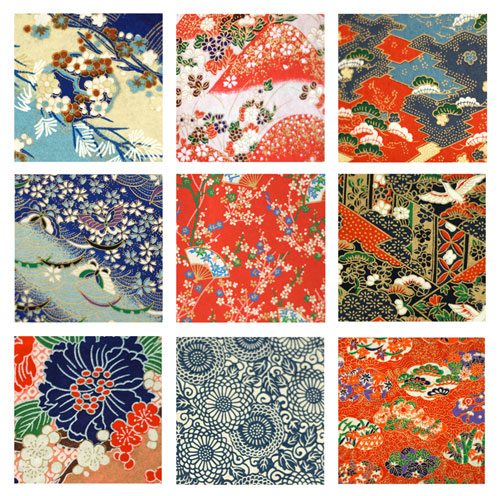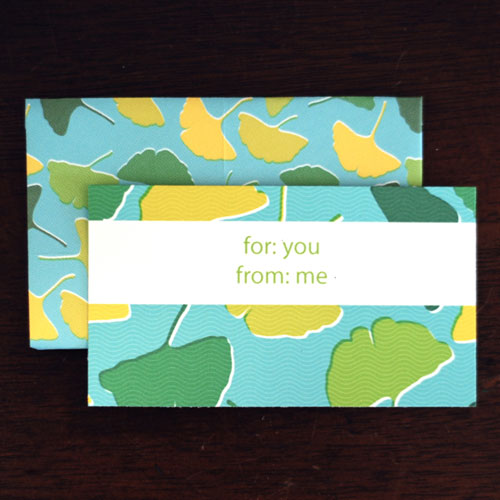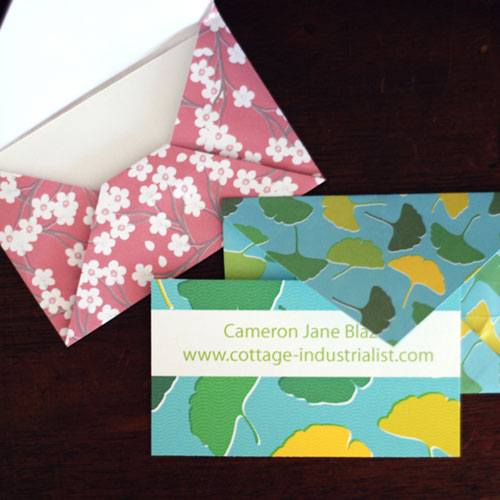Origami is something that I’ve always wanted to know more about, and Cameron from Cottage Industrialist — savvy pattern and printable designer, crafter, cook, and all-around cool chick — is here today to share fantastic origami paper information and several awesome, origami-inspired printables with us. Welcome, Cameron!

Thanks so much to Kristen for letting me guest post here. I love paper, and I love Paper Crave!
As long as I can remember, I have been drawn to the intricate patterns in origami paper, the bold colors, and the three-dimensional potential in a flat sheet of paper. I began collecting it in earnest about 20 years ago, and although I tend to hoard it, saving the beautiful sheets for just the right project, I have used the paper for bookbinding, collage, card making, and more.
Origami means “folding paper” in Japanese, and while there is a recognizable je ne sais quois about certain papers, origami can be done from a wide array of papers treated with a wide array of printing processes.
The finest origami papers are handmade from mulberry, gampi, or mitsumata pulp; these sturdy, beautiful papers are known as washi. But fine origami papers need not be handmade to be beautiful and special. “Yuzen” or “chiyogami” are what most people think of when they think of origami paper. These are usually machine-made papers which are hand silkscreened or block printed with highly detailed decorative designs. Chiyogami designs are often inspired by the gorgeous textiles of the Japanese Edo period. The richness of the colors and the frequent use of gold or silver foils is characteristic of these designs.
Although there are seemingly endless patterns of origami paper, there are a number of motifs that turn up over and over in the finest papers. The photo montage above highlights the details of some of my favorite sheets and demonstrates these common motifs: blossoms (plum or cherry, usually), mountains, bonsai, butterflies, fans, geometrics, cranes, peonies, chrysanthemums, maple leaves, and bamboo.
Little did I know when I started collecting origami papers all those years ago that I would return to them decades later as teaching tools in my own pattern designs. I have been designing textile and paper patterns now for several years, and I am inspired and educated regularly by the work of the Japanese pattern masters whose skills and sensibilities have been centuries in the making.
One of my favorite motifs is the ginkgo leaf, and I am surprised to say that I have never seen a commercially available origami paper featuring the tree or its leaves. Well, humble though this offering may be, I intend to change all that!

I have created a ginkgo origami pattern, along with easy-to-follow instructions for crafting your own business-card-sized origami envelope (takes about 2 minutes) and calling/enclosure cards to slip inside.
Download the ginkgo calling card and the ginkgo envelope.

And because I can’t let well-enough alone, I’ve also created a version covered in sakura, or cherry blossoms. Because who doesn’t love cherry blossoms?
Download the sakura calling card and sakura envelope.
The instructions will work for any sized square sheet of paper, but you need to use my slightly odd-sized paper to create an envelope perfectly suited to a business card. And the cards themselves can be printed on any card stock, but will pop out with no cutting required if you use Avery products 5881, 8373, or 8869.
images from Cottage Industrialist






